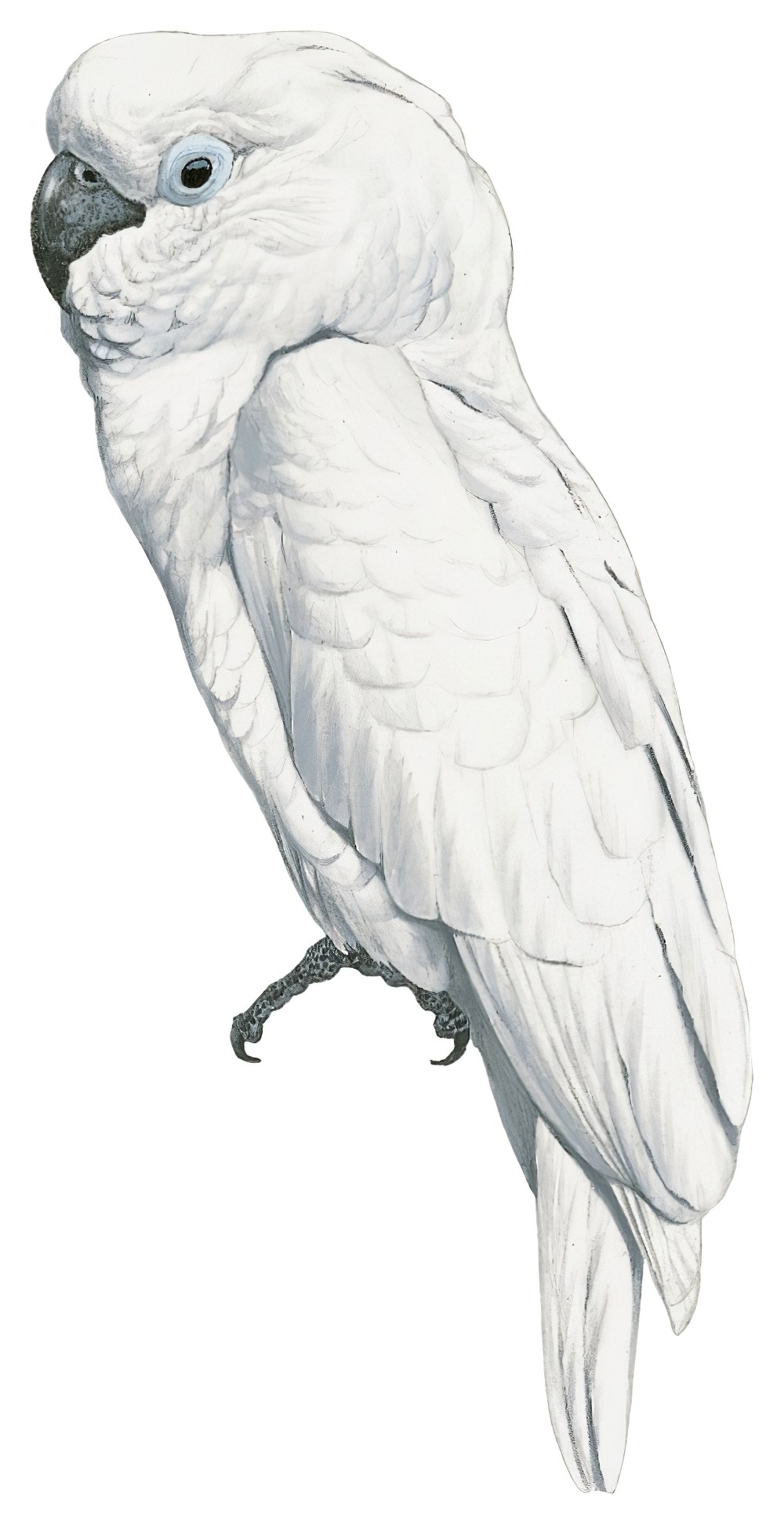White Cockatoo / Cacatua alba

White Cockatoo
SCI Name:
Protonym: Psittacus albus Natursyst.Suppl. Suppl. p.76
Taxonomy: Psittaciformes / Cacatuidae / Cacatua
Taxonomy Code: whicoc1
Type Locality: Moluccan Islands.
Author: Statius Muller
Publish Year: 1776
IUCN Status: Endangered
DEFINITIONS
CACATUA
(Cacatuidae; Ϯ White-crested Cockatoo C. alba) Malay names Kakatúa or Kakak-túa for the cockatoos. The origin of the Malay name is unclear; kakatuwah vice, alludes to the powerful bill; "older sister" from kakak sister + tua old, for its noisy sororal behaviour; “KAKATOÈS, Cacatua, Briss.; Psittacus, Lath. ... Les noms kakatoès, cacatou, cacacoua, sont dérivés du cri des espèces à plumage blanc, les seules qui fussent connues de Brisson et de Buffon; elles habitent principalement les îles de l'Océan indien, telles que les Moluques, les Philippines, celles de la Sonde et de la mer Pacifique. ... Le KAKATOËS BANKSIEN, Cacatua banksii, Vieill.; Psittacus banksii, Lath. ... Le KAKATOËS A BEC COULEUR DE CHAIR, Cacatua Philippinarum, Vieill.; Psittacus Philippinarum, Lath., Buff. ... Le KAKATOËS A HUPPE BLANCHE, Cacatua cristata, Vieill.; Psittacus cristatus, Lath. ... Le KAKATOËS A HUPPE JAUNE, Cacatua sulphurea, Vieill.; Psittacus sulphureus, Lath. ... Le KAKATOËS A HUPPE ROUGE, Cacatua rosacea, Vieill.; Psittacus rosaceus, Lath.; Psittacus moluccensis, Gmel. ... Le KAKATOËS JING-WOS, Cacatua galerita, Vieill.; Psittacus galeritus, Lath. ... se trouve aussi à la Chine, où elle porte le nom de Jing-wos (oiseau qui parle) ... Le KAKATOËS A TÊTE ROSE, Cacatua roseicapilla, Vieill. ... Le KAKATOËS A TÊTE ROUGE, Cacatua galeata, Vieill.; Psittacus galeatus, Lath.” (Vieillot 1817); "Cacatua Vieillot, Nouv. Dict. d'Hist. Nat. vol. xvii. p. 6, Dec. 27th, 1817: new name for Plyctolophus Vieillot." (Mathews 1927, 312); "CACATUA Vieillot, 1817 F — Cacatua cristata, 1817; type by subsequent designation (Salvadori, 1891, Cat. Birds Brit. Mus., 20, pp. 115, 124). = Psittacus albus Statius Müller, 1776." (Dickinson & Remsen (eds.) 2013, 354).
Synon. Cacatoes, Cacatus, Camptolophus, Ducorpsius, Eucacatua, Kakatoe, Licmetis, Lophochroa, Plissolophus, Plyctolophus.
alba
L. albus white, dead white (cf. candidus glittering white) (see also albus).
● "76. ARDEA. ... alba. 17. A. capite lævi, corpore albo, rostro rubro. Ardea tota alba, capite lævi. Fn. svec. 132. Ardea alba major. Will. orn. 205. t. 43. Raj. av. 99. n. 4. Habitat in Europa." (Linnaeus 1758) (Ardea).
● ex “Cacatua” of Brisson 1760, and “Kakatoës des Moluques” of d’Aubenton 1765-1781, pl. 263 (Cacatua).
● ex “White Sheathbill” of Latham 1785, and “Vaginalis” or “Chionis” of Forster 1788 (Chionis).
● ex “Fedoa canadensis, rostro recurvo” of Edwards 1750, and “Limosa candida” of Brisson 1760 (?syn Limosa haemastica).
● "99. MOTACILLA. ... alba. 12. M. pectore nigro, rectricibus duabus lateralibus dimidiato oblique albis. Motacilla pectore nigro. Fn. svec. 214. Motacilla. Gesn. av. 618. Aldr. orn. l. 17. c. 23. Bell. av. 88. 6. Will. orn. 171. t. 42. Raj. av. 75. n. 1. Alb. av. 1. p. 49. t. 49. Frisch. av. . t. 23. f. 4. Olin. av. 43. Habitat in Europa." (Linnaeus 1758) (Motacilla).
● ex “Spatule blanche de L’Île de Luçon” of Sonnerat 1776. “Mr Ogilvie Grant argues for the adoption of Scopoli’s name of P. alba, founded on Sonnerat’s plate. Although the bird is said to have come from Luzon, it is well-known that many of Sonnerat’s species were obtained in Africa, and set down in error as being from the Philippines. That this has been the case with the present species hardly admits of a doubt” (Sharpe 1898) (Platalea).
● ex “Guira Panga” or “Cotinga Blanc” of de Buffon 1770-1783 (Procnias).
● ex “White-breasted Petrel” of Latham 1785 (Pterodroma).
● ex “Mouette cendrée tachetée” (= ☼) of d’Aubenton 1765-1781, pl. 387 (syn. Rissa tridactyla).
● ex “Gobe-mouche blanc huppé du Cap de Bonne Espérance” of d’Aubenton 1765-1781, pl. 234, fig. 2 (syn. Terpsiphone paradisi).
● ex “Curiçaca” of Marcgrave 1648, and “Courlis à col blanc de Cayenne” of d’Aubenton 1765-1781, pl. 976 (syn. Theristicus caudatus).
● ex “Aluco minor” of Aldrovandus 1603, “Common Barn-Owl”, “White-Owl” or “Church-Owl” of Ray 1676, and “Common Barn-Owl” or “White Owl” of Albin 1731 (Tyto).
UPPERCASE: current genus
Uppercase first letter: generic synonym
● and ● See: generic homonyms
lowercase: species and subspecies
●: early names, variants, mispellings
‡: extinct
†: type species
Gr.: ancient Greek
L.: Latin
<: derived from
syn: synonym of
/: separates historical and modern geographic names
ex: based on
TL: type locality
OD: original diagnosis (genus) or original description (species)












